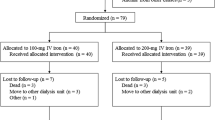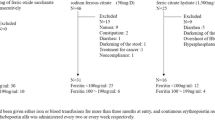Abstract
In patients with renal anemia, iron therapy can be administered intermittently or regularly at a low dose. We performed a randomized clinical trial in pediatric patients with end-stage renal failure on hemodialysis and absolute or functional iron deficiency. The study group received maintenance iron therapy according to the ferritin serum levels and the control group received intermittent 10-weekly doses. Success was defined as stabilization of ferritin levels between 100 and 800 μg/l and transferrin saturation (TSAT) between 20% and 50%, in addition to an increase in the hemoglobin level. The major reason for exclusion was iron overload. The study group received 6 mg/kg per month of parenteral iron [95% confidence interval (CI) 3.3–8.8] and the control group 14.4 mg/kg per month (95% CI 12–16.8) (P<0.001). After 4 months of treatment, ferritin levels increased to 66 μg/l (95% CI 69–200) in the study group and to 334 μg/l (95% CI 145–522) in the control group (P=0.009). Maintenance therapy and intermittent weekly doses were successful in 73% and 38%, respectively. After 3 months of treatment, hemoglobin levels increased to 10 g/dl, with no difference between the groups. However, in the control group the increase in hemoglobin levels was unsustained, and 3 patients needed transfusion. Patients in the control group had a higher risk of iron overload than patients in the study group (70% vs. 19%). Thus, the regimen based on assessment of serum ferritin levels was more efficient than the intermittent regimen because it increased and maintained the hemoglobin levels with lower iron doses and a lower risk of iron overload.




Similar content being viewed by others
References
Nimer SD, Wocott DL (1991) Recombinant human erythropoietin and renal anemia: molecular biology, clinical efficacy, and nervous system effects. Ann Intern Med 114:402–416
Warady BA, Jabs K (1995) Nuevas hormonas en el arsenal terapéutico de la insuficiencia renal crónica: hormona del crecimiento y eritropoyetina. Pediatr Clin North Am 6:1466–1480
Harmon WE, Jabs KL (1999) Hemodialysis. In: Barrat TM, Avner ED, Harmon WE (eds) Pediatric nephrology, 4th edn. Lippincott Williams and Wilkins, USA, pp 1277–1279
Nissenson AR, Strobos J (1999) Iron deficiency in patients with renal failure. Kidney Int 55 [Suppl 69]:S18–S21
Van Wyck DB, Stivelman JC, Ruiz J, Kirlin LF, Katz MA, Ogden DA (1989) Iron status in patients receiving erythropoietin for dialysis-associated anemia. Kidney Int 35:712–716
Fishbane S, Frei GL, Maesaka J (1995) Reduction in recombinant human erythropoietin doses by the use of chronic intravenous iron supplementation. Am J Kidney Dis 26:41–46
Macdougall IC (1999) Strategies for iron supplementation: oral versus intravenous. Kidney Int 55 [Suppl 69]:S61–S66
Ifudu O (1998) Parenteral iron: pharmacology and clinical use. Nephron 80:249–256
Fishbane S, Mittal SK, Maesaka JK (1999) Beneficial effects of iron therapy in renal failure patients on hemodialysis. Kidney Int 55 [Suppl 69]:S67–S70
Macdougall IC, Chandler G, Orlaith E, Harchowal J (1999) Beneficial effects of adopting an aggressive intravenous iron policy in a hemodialysis unit. Am J Kidney Dis 34 [Suppl 2]:S40–S46
Seeherunvong W, Rubio L, Abitbol CL, Montane B, Strauss J, Diaz R, Zilleruelo G (2001) Identification of poor responders to erythropoietin among children undergoing hemodialysis. J Pediatr 138:710–714
Bristian BR, Khaodhiar L (1999) The systemic inflammatory response and its impact on iron nutriture in end-stage renal disease. Am J Kidney Dis 34 [Suppl 2]:S35–S39
Abbas AK, Lichtman AH, Pober JS (1999) Inmunología celular y molecular, 3er edn. Interamericana McGraw-Hill, pp 234–253, 275–308
Eschbach JW, Adamson JW (1999) Iron overload in renal failure patients: changes since the introduction of erythropoietin therapy. Kidney Int 55 [Suppl 69]:S35–S43
Park L, Uhthoff T, Tierney M, Nadler S (1998) Effect of an intravenous iron dextran regimen on iron stores, hemoglobin, and erythropoietin requirements in hemodialysis patients. Am J Kidney Dis 31:835–840
Kalantar-Zadeh K, Don BR, Rodríguez RA (2001) Serum ferritin is a marker of morbidity and mortality in hemodialysis patients. Am J Kidney Dis 37:564–572
National Kidney Foundation-Dialysis Outcomes Quality Initiative (1997) Clinical practice guidelines for the treatment of anemia of chronic renal failure. Am J Kidney Dis 30:192–240
Tarng DCH, Huang TP, Chen TW, Yang WCH (1999) Erythropoietin hyporesponsiveness: from iron deficiency to iron overload. Kidney Int 55 [Suppl 69]:S107–S118
Morgan HEG, Gautam M, Geary DF (2001) Maintenance intravenous iron therapy in pediatric hemodialysis patients. Pediatr Nephrol 16:779–783
Macdougall IC, Cavill I, Hulme B, Bain B, McGregor E, McKay P, Sanders E, Coles GA, Williams JD (1992) Detection of functional iron deficiency during erythropoietin treatment: a new approach. BMJ 304:225–226
Owen WF, Szczech L, Johnson C, Frankenfield D (1999) National perspective on iron therapy as a clinical performance measure for maintenance hemodialysis patients. Am J Kidney Dis 34 [Suppl 2]:S5–S11
Besarab A, Kaiser J, Frinak S (1999) A study of parenteral iron regimens in hemodialysis patients. Am J Kidney Dis 34:21–28
Besarab A, Amin N, Ahsan M, Vogel SE, Zazuwa G, Frinak S, Zazra JJ, Anandan JV, Gupta A (2000) Optimization of epoetin therapy with intravenous iron therapy in hemodialysis patients. J Am Soc Nephrol 11:530–538
Sepandy F, Kindal K, West M, Hirsch D (1996) Economic appraisal of maintenance parenteral iron administration in treatment of anaemia in chronic haemodialysis patients. Nephrol Dial Transplant 11:2319–2322
Taylor JE, Peat N, Porter C, Morgan AG (1996) Regular low-dose intravenous iron therapy improves response to erythropoietin in haemodialysis patients. Nephrol Dial Transplant 11:1079–1083
St Peter WL, Lambrecht LJ, Macres M (1996) Randomized cross-over study of adverse reactions and cost implications of intravenous push compared with infusion of iron dextran in hemodialysis patients. Am J Kidney Dis 28:523–528
Flores FX, Jabs K, Harmon WE, Somers MJG (1999) Safety and efficacy of intravenous iron dextran in pediatric hemodialysis patients. Pediatr Res 45:331A
Tenbrock K, Müller-Berghaus J, Michalk D, Querfeld U (1999) Intravenous iron treatment of renal anemia in children on hemodialysis. Pediatr Nephrol 13:580–582
VanWyck DB (1989) Iron management during recombinant human erythropoietin therapy. Am J Kidney Dis 14 [Suppl 1]:9–13
Pocock SJ (1993) Monitoring trial progress. In: Pocock SJ (ed) Clinical trial. A practical approach. Wiley, 142–159
Rocco MV, Bedinger MR, Milam R (2001) Duration of dialysis and its relationship to dialysis adequacy, anemia management, and serum albumin level. Am J Kidney Dis 38:813–823
Acknowledgements
We thank the staff at the hemodialysis unit at Hospital of Gineco Obstetricia 48 IMSS León, Gto. The Research was supported by CONACYT-SIHGO grant number 2000–02–02–003 and Fondo para el Fomento a la Investigación (FOFOI) del Instituto Mexicano del Seguro Social.
Author information
Authors and Affiliations
Corresponding author
Rights and permissions
About this article
Cite this article
Ruiz-Jaramillo, M.C., Guízar-Mendoza, J.M., Gutiérrez-Navarro, M.J. et al. Intermittent versus maintenance iron therapy in children on hemodialysis: a randomized study. Pediatr Nephrol 19, 77–81 (2004). https://doi.org/10.1007/s00467-003-1288-9
Received:
Revised:
Accepted:
Published:
Issue Date:
DOI: https://doi.org/10.1007/s00467-003-1288-9




